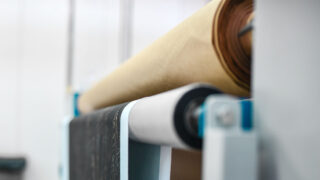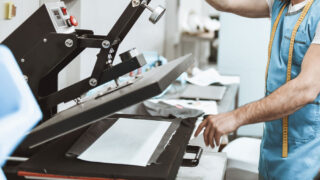Special Techniques in Printing
Resist Printing
In resist printing, the fabric is first printed in a design with a chemical that resists dye. The fabric is then dyed. The resist chemistry will leave the fabric white or a lighter version of the base color in the printed areas. One of the advantages of this method is that dyes with very high colorfastness can be used. Resist printing can be performed on cotton fabrics that will subsequently be dyed with reactive, vat or naphthol dyes. This combination of printing and dyeing is very similar to the ancient method of batik.
Discharge Printing
With discharge printing, the fabric is first dyed to the desired ground color, usually a dark shade. Next, the fabric is then printed with a chemical that selectively destroys the dye. This leaves a white discharge design in the ground color. As an alternative, a combination of the discharging agent and a dye is printed onto the fabric. The discharge agent destroys the ground color and the dye replaces the ground color in the design. The dye used must be unaffected by the discharge agent. This yields special color effects of a color discharge design surrounded by a stable ground color. Using this method, it is possible to surround delicate colors and intricate colors with deep ground colors.
Discharge printing has higher production costs than normal printing techniques. Designs not easily achieved with other printing methods can be produced by discharge printing. Care must be taken to choose ground colors that can be selectively destroyed without extraordinary means and without damaging the textile fabric
Transfer Printing
Transfer printing involves the transfer of color from one surface, usually paper, to a second surface. The most common method is heat transfer printing, where the design is first printed on paper and then transferred onto a garment or fabric. For cotton, the only widely used commercial process involves printing release paper with pigments for logo printing onto t-shirts and other garments.
The first step in this process is to place the garment onto the bed of the press. The printed transfer paper is then placed on the garment and the press is closed applying both heat and pressure.
The heat softens and releases the pigment binder from the paper and adheres the logo to the garment. The release temperature is usually around 375 degrees Fahrenheit or 190 degrees Celsius. Garments printed using this process must be treated with caution when ironed or exposed to excessive heat. Additionally, these prints will exhibit all the characteristics of pigment prints, both good and bad. For fabrics, transfer print patterns can also be applied using dyestuff that is normally used in dyeing and wet printing. Cotton fabrics must be pre-treated to allow for fixation of the dyes. The desired pattern, in reverse mode, is printed onto the transfer paper. This paper is then placed onto the pre-treated fabric under heat and pressure and the dyes are transferred.
Transfer printing continues to grow in popularity because the process is efficient and a wide variety of colors and patterns can be applied with great clarity and definition. In addition, labor requirements and floor space are less at the print house and less water and other chemistries are used. However, this system requires longer runs to be profitable since the patterns must be printed onto the paper and rotary printing is normally used. In a typical application, a service company would make the pattern paper.


